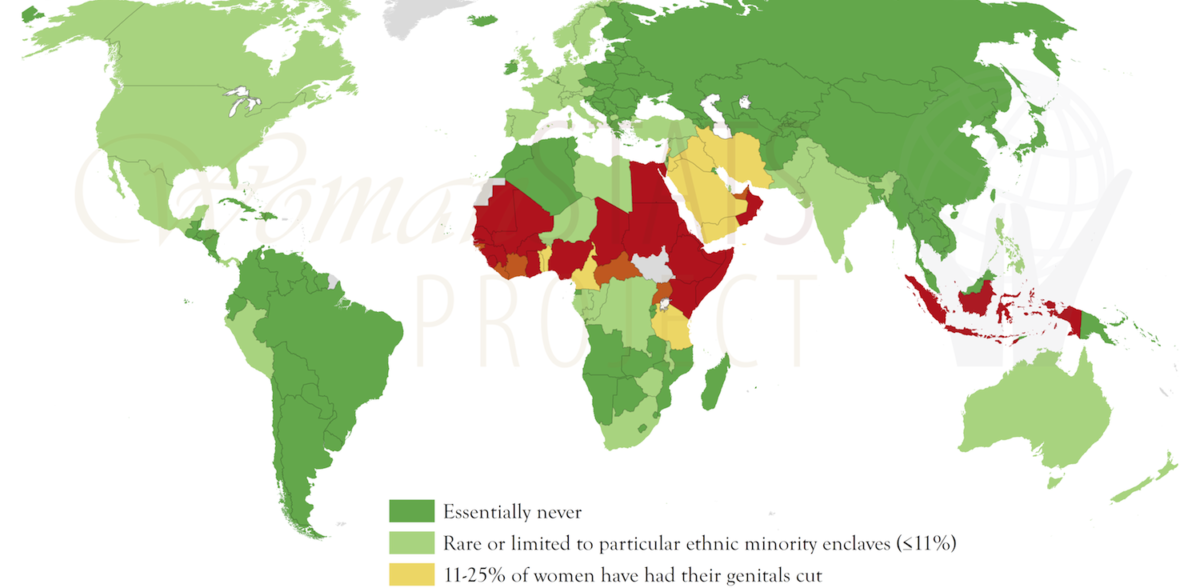Female Genital Mutilation: A Global Issue

Kuhu Misra is a second year undergraduate pursuing law from IP University, Delhi. Apart from being a Bibliophile, she also dabbles in amateur blogging and various oratory programs.
Female Genital Mutilation: A Global Issue
I did the very best I could to tell them they were hurting me. If they had heard, they would have stopped, but children are to be seen and not heard. And so they kept cutting and cutting .
INTRODUCTION
The quotation above is not merely a phrase but a tale of horror of thousands of victims all around the globe forced to undergo circumcision of their genitals. The most important thing an individual can claim right over is their mind and body but with such barbaric practices even that is taken away from him/her. Through this blog I would like to shed some light on the issue of Female Genital Mutilation – a torture which needs to be stopped!
Female Genital mutilation (FGM), also known as female genital cutting and female circumcision, is the ritual removal of some or all of the external female genitalia, or other injury to the female genital organs for non-medical reasons. The practice is mostly carried out by traditional circumcisors who play a central role in the conservative societies and perform the circumcision usually at child birth. In many cases the circumcision is performed under the guise of medical safety of the girl child till the time she attains puberty.
Female genital mutilation is internationally recognised as a human right violation of girls and women. It is a reflector of the deep rooted disease of inequality between the sexes which strives to create difficulties in the path of a woman treading on the journey of exploring her sexuality, thereby subjugating her to the control of the male section of the society.
PROCEDURE
Female genital mutilation is classified into 4 major types,namely:
Type 1: Clitoridectomy
Type 2: Excision
Type 3: Ifibulations
Type 4: Procedures for non medical purposes.
Factors responsible for the performance of FGM:-
Now after reading a background guide on the procedure and meaning of genital mutilation, the question that arises in the minds of the reader is, why in the first place, is genital mutilation performed?
The answer to this question is, every society has its own myths and beliefs and the reason why genital mutilation is performed also varies from one region to another. But the most commonly cited reasons are:
In some areas FGM is a social convention and all the members of that certain community are bound to follow this procedure as they live under the fear that if they fail to perform the ceremony, they will be declared as an outcast.
FGM is often considered as a way to prepare the girl for adulthood and marriage.
FGM also reflects our social and religious beliefs. In our society the girl given in marriage is expected to be virgin and any kind of extra marital affair is certainly out of bounds. Therefore to protect the chastity and so called “purity” of the girl her genitals are mutilated so that she cannot give in to her sexual desires.
Usually in our society the reproductive parts are considered impure and clean; therefore in order to cleanse and beautify the girl, FGM is performed.
Although the practice of FGM has no religious sanction many people believe that doing so has its root in their religion of their practice. In many communities even the religious heads or community heads authenticate such practices and even provide monetary support for doing so.
Lastly in some cases, the community which are non practitioners of such practices ape their neighbouring communities out of the fear that if they dont practice such things they would be left behind in prestige and honour in the society at large.
HEALTH RISKS
The procedure of genital mutilation is mostly carried on young girls between infancy and adolescence, and occasionally on adult women. More than 3 million girls are estimated to be at risk for FGM annually. More than 200 million girls and women are estimated to have been cut in 30 countries Africa, Middle East and Asia where FGM is concentrated.
Anything removed from its natural habitat results in destruction in one way or the other. In the same way when a healthy and normal genital tissue is removed from its natural place it brings about destruction in the form of health risks for women which in some cases can be quite serious in nature. The complications arising due to the procedure are both short term and long term. The short term complications being severe pain, genital tissue swelling, urinary problems, shock, death etc. The long term complications being sexual problems, urinary problems scar tissue and keloid, psychological problems etc.
Organizations working to stop FGM
There are many organizations striving at the grassroots, state, national and international levels to put a stop to Female Genital Mutilation. Here are some organisations who work at the national and global levels to curb this torture and crime.
Real life account of a survivor
An FGM survivor, Aisha, recalls the horror tale of her cutting. She and her younger sister were cut when they were aged 6 and 3 years respectively. They were taken by a village woman to the outskirts of the village to a hut where other women were singing and beating drums. They were taken to a fence covered with leaves and blindfolded and three women caught hold of them so they could not wriggle out of their grip and then they were cut.
After the cutting the sisters and the other girls were left for hours in dirty black holes to bleed and cry. When few hours passed all the girls were transferred to the hut of the cutter where they were to live for a period of three months. During these three months they would receive treatment in the form of placing leaves on their cut and then ripping it off to put another till the time a scar started to form on their cuts and were threatened by the ladies that if ever they told anybody about the rituals, they would be killed. On the completion of three months of the ritual of genital mutilation, a celebration was organised after which the girls could go to their homes.
When the victim Aisha confronted her mother about the practice she was told that she had done it in order to protect her and her younger sister. The practice undertaken to “protect” her daughters had in turn “scarred” them for their lifetime.
WHO Response
In 2008, the World Health Assembly passed resolution WHA61.16 on the elimination of FGM, emphasizing the need for concerted action in all sectors- health, education, finance, justice and womens affairs. WHO’s efforts to eliminate female genital mutilation focus on strengthening the health sector, building evidence and increasing advocacy against FGM.
CONCLUSION
I would like to conclude by saying that, only the physical attributes of a woman do not make her a woman. A woman is made by the strength of her mind and soul which can counter any problem at any point of time in her life. By mutilating her organs you cannot cut her wings to fly. A woman is born to fly high and she will fly higher and higher in spite all the hurdles placed in her way.


